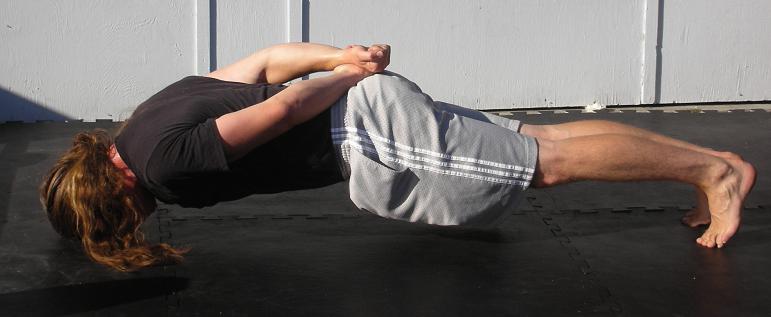As a kid I was always skinny. I mean very skinny. Entering high school I weighed less than 100 lbs. I played football there and lifted weights though I wasn’t really good at either.
The truth is I only really started seeing results in my strength and body when I got into bodyweight exercises about the end of school. After a year or two of consistent work in bodyweight training I ran across an old friend. His first statement to me:
“Wow! Your neck filled out.”
Guess what I had been doing? Various forms of bridging. Looking back I’ve been doing these exercises for about ten years now; and in this article I want to share with you some variations. If you’ve been doing Convict Conditioning for awhile you may be able to get started with these, because the truth is all these are more advanced than the basic holds.
Weighted Bridging
I started adding weight to my bridges because I was getting bored with long static holds. My best ever hold was ten minutes in a hands free wrestler’s bridge. I know I could have gone further but I didn’t want to. What can I say? I get bored easily and 10 minutes is about my maximum attention span.
I first did this with people, but I started using weight simply because I didn’t always have a person to sit or stand on me. In the beginning I’d pull over a light kettlebell and hold it. Then two kettlebells. Eventually I had to move inside a power rack as getting the weight into place proved harder than the hold.
I don’t recommend going this far for most people I just wanted to see how far I could take it and follow in line with guys like George Hackenschmidt who supported big weights in this position. If you work up to even a light weight you’ll probably have more than enough neck strength for your daily life, unless you’re involved in sports or martial arts.
To give you an idea of what can be achieved this video shows my current best hold. It’s a very brief support of over 600 lbs. split over the barbell and Bud Jeffries sitting on me. I plan to take this support to over half a ton in the future.
Neck Plank
As the wrestler’s bridge became too easy and I had to do something to make it harder, so the same was true of the front bridge. I experimented with adding weights but my favorite came from extending the leverage. For this you start in the front bridge position and walk your legs back while keeping your forehead on the ground. It’s like a plank position where only your forehead and toes are on the ground, with the stress being on your neck (and your abs as well to some degree) hence the name.

Dynamic Bridging
The static holds are great and make up a large part of bridging. But they’re not the only things you can do.
The next couple exercises are dynamic in nature and thus train the body in a slightly different way. Both involve going from the front to back bridge position albeit in different ways. Check out this video to see both in action.
Bridge Kickovers
This move takes a good degree of strength, flexibility and acrobatic ability all at the same time. You must start in a wrestler’s bridge with the hands on the ground.
To get started I like to rock three times from my toes to chest, kicking with one leg hard, on the third go. The leg kicks up and over, then the other comes to follow it. You’ll land in a front bridge position although it’ll be far from perfect. From here you can kick one or both legs back to end in the wrestler’s bridge once again. When you’re first starting out one rep at a time is fine. When you get good you can go back and forth very quickly.
Only progress to the hands free version if you have lots of practice and are sure your neck can take it. It is significantly tougher to do. If you don’t quite make it over you may end up spinning and coming down in an awkward manner which you want to avoid.
Either of these variations can be made progressive by kicking off of a raised stable surface.
Bridge Twists
This final bridging exercise involves twisting from a back to a front bridge. This works every single muscle in your neck as you go to the sides, as well as some interesting spine action taking place.
This is great for improving your flexibility and is commonly done by wrestlers. As before, be sure to start with your hands and become great at that before moving to the hands-free position.
You’ll also find it easier if you stay more towards the back of your head.
That should give you some new variations to play with. Don’t try to do these all at once. In fact, I’ve found that a little bridging goes a long way. If you have any questions be sure to ask below. Also if you’d like to see me write more on gymnastic bridge variations (on top of these wrestler’s bridging exercises) for you to play with, then let me know.
—
Logan Christopher has been called a physical culture renaissance man as he is accomplished in a wide range of strength skills from kettlebell juggling, performing strongman stunts, and bodyweight exercises. He is the author of numerous books including Secrets of the Handstand and The Master Keys to Strength & Fitness. In addition, he’s spent the last several years going deep into mental training to find out what it takes to really excel and tactics that can help people instantly improve their exercises. You can find out more about all this at http://www.LegendaryStrength.com.